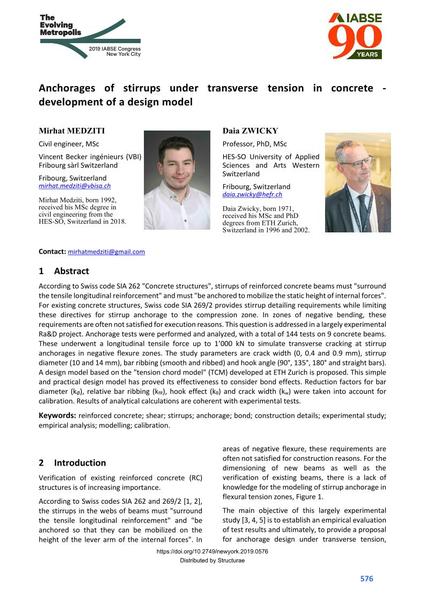Anchorages of stirrups under transverse tension in concrete - development of a design model

|
|
|||||||||||
Bibliografische Angaben
| Autor(en): |
Mirhat Medziti
(Vincent Becker ingénieurs (VBI) Fribourg sàrl Switzerland)
Daia Zwicky |
||||
|---|---|---|---|---|---|
| Medium: | Tagungsbeitrag | ||||
| Sprache(n): | Englisch | ||||
| Tagung: | IABSE Congress: The Evolving Metropolis, New York, NY, USA, 4-6 September 2019 | ||||
| Veröffentlicht in: | The Evolving Metropolis | ||||
|
|||||
| Seite(n): | 576-584 | ||||
| Anzahl der Seiten (im PDF): | 9 | ||||
| DOI: | 10.2749/newyork.2019.0576 | ||||
| Abstrakt: |
According to Swiss code SIA 262 "Concrete structures", stirrups of reinforced concrete beams must "surround the tensile longitudinal reinforcement" and must "be anchored to mobilize the static height of internal forces". For existing concrete structures, Swiss code SIA 269/2 provides stirrup detailing requirements while limiting these directives for stirrup anchorage to the compression zone. In zones of negative bending, these requirements are often not satisfied for execution reasons. This question is addressed in a largely experimental Ra&D project. Anchorage tests were performed and analyzed, with a total of 144 tests on 9 concrete beams. These underwent a longitudinal tensile force up to 1’000 kN to simulate transverse cracking at stirrup anchorages in negative flexure zones. The study parameters are crack width (0, 0.4 and 0.9 mm), stirrup diameter (10 and 14 mm), bar ribbing (smooth and ribbed) and hook angle (90°, 135°, 180° and straight bars). A design model based on the "tension chord model" (TCM) developed at ETH Zurich is proposed. This simple and practical design model has proved ist effectiveness to consider bond effects. Reduction factors for bar diameter (kØ), relative bar ribbing (kfR), hook effect (kθ) and crack width (kw) were taken into account for calibration. Results of analytical calculations are coherent with experimental tests. |
||||
| Stichwörter: |
Modellbildung Ankerblock Stahlbeton Schub Kalibrierung Konstruktionsdetails
|
||||
